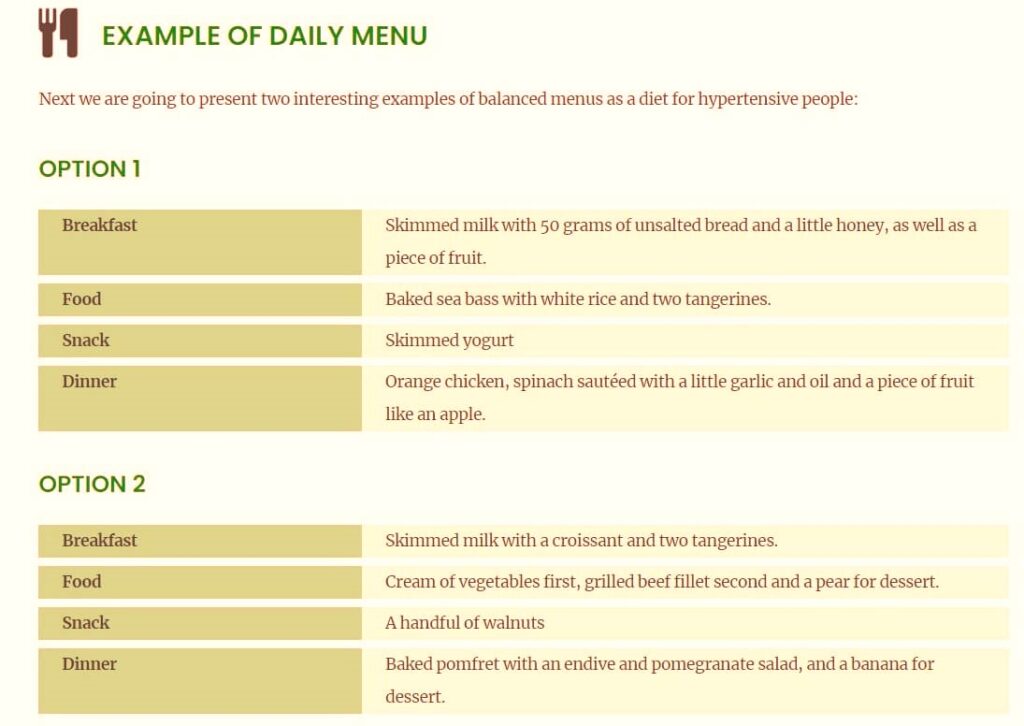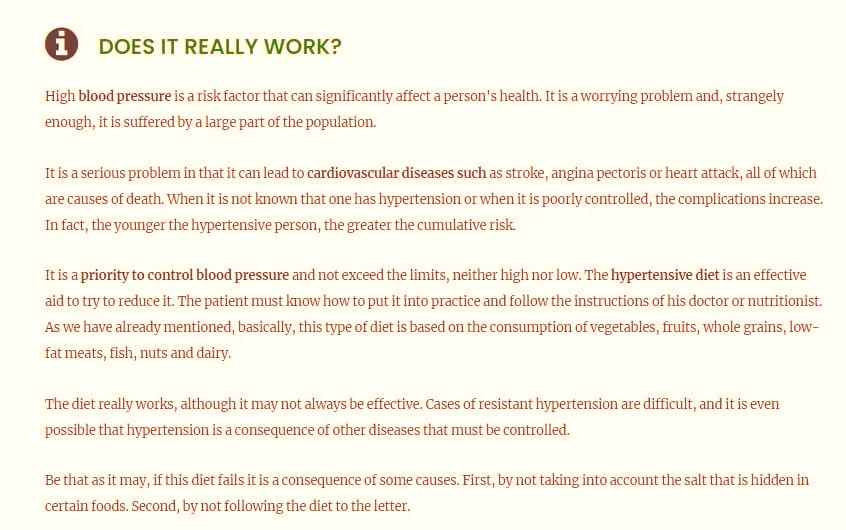high blood pressure diet menu: The feed is a key part in each stage of life. It is important to carry a series of healthy habits that provide a balance in people to avoid various diseases.
THE DASH DIET
This diet is especially suitable for people suffering from hypertension. It has been shown to be effective in helping to lower blood pressure. Its effects can be seen after a few weeks.
This diet is rich in fiber and important nutrients. It also includes foods rich in calcium, magnesium and potassium. The goal of this type of diet is to reduce sodium to 1,500 milligrams per day and optimally reduce saturated fat and total body fat.
For this it is good to eat legumes and seeds every day , as well as fresh vegetables and fruits . Similarly, choose foods rich in protein such as skinless poultry, soy products, and fish.
The low – fat dairy products are also recommended with the intention of lowering systolic blood pressure. Another goal is to reduce cholesterol and carbohydrates to include them in their proper measure.
Hypertension or arterial pressure is the force exerted by the blood inside the arteries. When these cavities become narrow they create pressure and the blood rises. This can cause severe damage to the arteries and decreased blood flow through the body causing the heart to work hard.

A diet for hypertensive patients can bring multiple benefits in the daily care of the patient. It is important to follow a series of easy-to-follow healthy recommendations without feeling anxious or reluctant to eat.
Hypertensive Diet
A diet for hypertensive patients must be based on the high consumption of fruits and vegetables that help tension due to their high quality in fiber and potassium.
There are specific and special foods to keep tension levels at bay and to significantly improve the quality of life of the patient.
high blood pressure diet menu
- Banana or plantain: Eating two bananas a day can reduce high blood pressure levels by around 10%. In addition, they contain a large amount of potassium and fiber.
- Ricotta Cheese: It is ideal because it is not only low in sodium, it helps regulate blood sugar and the production of Angiotensin, which is what blocks the artery. In addition, it is very versatile for cooking.
- Onion: Garlic and onion are one of the most recommended foods to lower pressure in natural medicine because they are vasodilators. These vegetables improve circulation, help fight cholesterol and the patient’s arterial health.
- Coconut water: Hydration plays a critical role in a high-pressure diet. Drinking at least 8 glasses of water a day is recommended.
- Dark chocolate: Raises serotonin and this in turn runs and cares for the arteries keeping them clean. It is ideal for keeping the disease away while still feeling stressed by a strict diet. It is recommended that it contain more than 70% cocoa.
- Cucumber: Contains approximately 442mg of potassium. When the body has little of this mineral, the body begins to retain sodium and the symptoms of hypertension can appear suddenly due to fluid retention.
- Extra virgin olive oil: It is a healthy fat rich in free radicals that permanently inactivates nitric oxide, a substance with a vasodilator effect. 2 to 3 tablespoons a day with salads and protein is recommended.
- Cereals or seeds: A diet rich in whole grains is ideal for its high fiber content. Oats, ground wheat, flaxseed among others. They promote the risk of hypertension up to 20%, preferably combined with skim milk and fresh fruit.
- Beetroot: Whether cooked or raw it is ideal for lowering blood pressure. It is recommended to ingest in juices, salads or desserts. Beetroot helps the absorption of nutrients in the blood by generating a protective shield in the blood flow in the arteries.
- Lemon: Helps to dilate blood vessels making them more flexible so that blood flow is fluid.

Read also: what foods good for high blood pressure
Prohibited Foods to avoid in the diet
There are highly recommended foods to eat in a diet for people with high blood pressure. However, it is important to know which ones should be avoided:
- Table salt: It is the main cause of hypertension. Furthermore, it promotes weight gain.
- Broths or instant soups: It is a commercial powder that substitutes for a soup broth. These contain large amounts not only of sodium but also of chemicals and flavorings that can generate an imbalance if they are consumed regularly.
- Sweet and salty snacks : Refined sugar and high sodium portions are against health. They obstruct the arterial cavity and force the heart to pump blood. With them increases the risk of suffering from diabetes without the patient noticing it.
- Canned: They have preservatives based on sodium. Although they are very easy to prepare, their consumption is not recommended since it can produce an imbalance in blood levels.
- Caffeine: Drinks such as coffee or caffeinated soft drinks directly influence the increase in blood pressure. It is advisable to replace them with freshly liquefied natural juices or infusions that do not alter the flow of blood in the body.
- Medications: There are drugs that can promote increased blood pressure. The specialist must study which medications are appropriate according to the patient’s clinical sheet so as not to be affected by any alteration. Especially in case of pregnancy, the doctor must preserve the health of the mother.
- Bread or pastries: Processed flours contain sodium and saturated fats that, when absorbed by the body, increase blood pressure. The problem is further aggravated when they are ingested excessively because they contain more than 15% of the recommended daily amount.
- Butter and kinds of margarine: The concentration of fat can affect the health of the arteries, obstructing the flow of blood. Furthermore, these substances slow down metabolic function because the patient can gain weight.
- Alcohol: Some beverages like red wine provide benefits for cardiovascular health. However, excess alcohol can not only increase pressure but also load the body with empty calories that can be metabolically harmful to the patient.

Menu and recipes to reduce tension
The following schematic shows an example of a menu or diet for hypertensive patients on a weekly basis:
Day 1:
- Breakfast: 1 bowl of oatmeal cooked with skim milk with fresh fruit. Omelette 1 yolk 2 whites.
- Snack 1: Greek yogurt sweetened with stevia and 5 almonds.
- Lunch: Green salad with chicken breast and baked potatoes .
- Snack 2: Freshly cut fruit salad.
- Dinner: Zucchini pasta with homemade Neapolitan sauce . (Use spices to substitute salt) Add mozzarella or ricotta cheese.
Day 2:
- Breakfast: Oatmeal pancakes with homemade light marmalade.
- Snack: Mix of natural nuts .
- Lunch: Broccoli cream with sweet potato puree and grilled fish fillet.
- Snack 2: Natural yogurt with chia seeds.
- Dinner: Caprese salad with sautéed aubergine.
Day 3:
- Breakfast: Arepa or corn tortilla with scrambled eggs and ricotta cheese .
- Snack 1: Light homemade jam with whole wheat biscuit.
- Lunch: Tuna omelette with sautéed vegetables and steamed potatoes.
- Snack 2: Whole wheat sandwich with turkey ham and lettuce mix.
- Dinner: Grilled fish fillet with steamed broccoli.
Day 4:
- Breakfast: Porrigde of oats with cinnamon and skim milk.
- Snack 1: Greek yogurt sweetened with stevia and 5 almonds.
- Lunch: Chard and zucchini cream with sweet potato puree and grilled fish fillet.
- Snack 2: Natural yogurt with chia seeds and chopped fruit.
- Dinner: Grilled fish fillet with steamed sauteed vegetables.
5th day:
- Breakfast: Arepa or corn tortilla with scrambled eggs and ricotta cheese.
- Snack 1: Light homemade jam with whole wheat biscuit and an infusion of preferably chamomile tea.
- Lunch: Tuna omelette with sautéed vegetables and steamed potatoes.
- Snack 2: Whole wheat sandwich with capresa salad.
- Dinner: Whole wheat spinach pasta with homemade Neapolitan sauce. (Use spices to substitute salt) Add mozzarella or ricotta cheese.




Living a healthy life is the key to stabilizing the patient. It is important to maintain a conscious diet that provides: Complex hydrates, proteins, healthy fats, vegetables, legumes.
Leading a healthy life is the key to stabilizing the patient. It is important to maintain a conscious diet that provides: Complex carbohydrates, proteins, healthy fats, vegetables, legumes.
It is recommended to carry out a moderate cardiovascular exercise to prolong the patient’s health without any risk factor and always supervised by a specialist.
Don’t miss: DASH Diet and High Blood Pressure
If you liked the post about high blood pressure diet menu You can share it on your favorite social networks (Twitter, Facebook, etc.…), ← you have different icons to click. Every day there will be new recipes and tricks for you, Follow us on Facebook @buzzrecipes12

